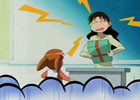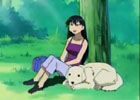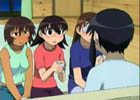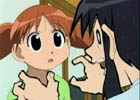Azumanga Daioh by Lady Sage
| Also Known As: Azu Dai, Azu Daioh, Azu | ||
| Genre: Comedy | ||
| Format: 26 Episodes | ||
| Allegiance: GENCO | ||
| Director: Nishikiori Hiroshi | ||
| Vintage: 2002 | ||
| Intelligence Agency Report by: Kuzu Ryu Sen | ||
| At first glance, one would expect a day with Class 1-3 to be as normal as with any other class. As one walks in the door, there’s the 10 year old genius girl with the pigtails reading. When the bell rings, there’s the screeching of the teacher struggling to make it on time. During class, there’s the tall quiet girl looking out the window at what appears to be a very cute cat-shaped cloud, with another girl staring at her with a red face… Directly in front, there’s the girl from Kansai staring blankly into air. Behind, the two childhood friends are arguing loudly again and whacking each other with their textbooks, but it’s fine because the teacher is too distracted by what’s happening in the class next door. Ah, just another day in the world ofAzumanga Daioh. | ||
|
|
| Field Agent Report by: Lady Sage | ||
| Plot Characters Impact Visual Audio |
8.00 10.00 9.50 9.50 10.00 |
|
| Overall | 9.50 | |
| (not an average) | ||
| There is no major conflict in this anime. There is no villain, no great plan to save the world. Heck, there isn’t even any particular plot beyond some carryover silliness. It’s just a group of friends going through high school, hanging out, and living their lives. The concept is the epitome of mundane. Heck, at least half the people who see it have gone through the same thing. And that is exactly why it works.The characters are not exactly developed in the traditional sense, but nor are they flat or clichéd. Instead, each has a strong, believable personality that complements the others’, which is good considering the comedy is almost completely character-driven. You’ll swear that at least one of them was based on someone you knew in high school, or maybe even yourself. The characters are aided by top-notch seiyuu work, from the hyper-kawaii Chiyo to the shrieking Yukari-sensei to the hilariously spacey and deadpan Osaka. The everyday plot and realistic characters create a powerful sense of realism, which makes for an emotional conclusion that will bring tears to the eyes of anyone with fond memories of high school.
Azumanga Daioh also excels in the technical areas. The animation is bright and clean-looking, and everyone moves smoothly. To be sure, it is not absolute top-quality, but since the series is dialogue- and character-driven, not action-driven, it’s acceptable. Especially notable is the character designs: each character has her own look without only being distinguishable by hairstyle. The music is diverse, ranging from funky ska-style trumpets to gentle flutes, always setting or complementing the mood perfectly. The opening theme song, Soramimi Cake, is an energetic piece that fits the hyperactive mood of the series perfectly, with matching animation that is actually a one-and-a-half minute summary of the entire show. The closing theme, Raspberry Heaven, in many ways captures the quieter, more peaceful side of Azumanga Daioh that is less prominent but no less pertinent. Unfortunately, Azumanga Daioh isn’t for everyone. Just as it may create an amazing sense of nostalgia for those who enjoyed high school, it may stir up unpleasant memories for those who did not. Others who prefer a coherent plot may not enjoy the format of five separate, albeit interrelated, vignettes per episode. Nor is the series an anime for beginners, since it requires a basic knowledge of Japanese culture and school life in Japan. Nevertheless, some things are universal, and the latter issue is one easily overcome. |
||




